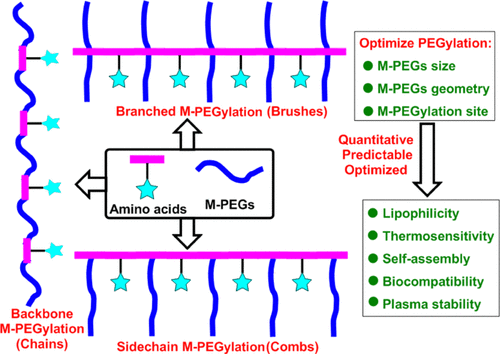当前位置:
X-MOL 学术
›
Biomacromolecules
›
论文详情
Our official English website, www.x-mol.net, welcomes your feedback! (Note: you will need to create a separate account there.)
Quantitatively Fine-Tuning the Physicochemical and Biological Properties of Peptidic Polymers through Monodisperse PEGylation.
Biomacromolecules ( IF 6.2 ) Pub Date : 2020-01-10 , DOI: 10.1021/acs.biomac.9b01425 Xuemeng Wang 1 , Yu Li 2 , Tingjuan Wu 3 , Zhigang Yang 1 , Xing Zheng 3 , Shizhen Chen 2 , Xin Zhou 2 , Zhong-Xing Jiang 1
Biomacromolecules ( IF 6.2 ) Pub Date : 2020-01-10 , DOI: 10.1021/acs.biomac.9b01425 Xuemeng Wang 1 , Yu Li 2 , Tingjuan Wu 3 , Zhigang Yang 1 , Xing Zheng 3 , Shizhen Chen 2 , Xin Zhou 2 , Zhong-Xing Jiang 1
Affiliation

|
In biomedicine, PEGylation is one of the most successful strategies to modify the physicochemical and biological properties of peptides, proteins, and other biomacromolecules. Because of the polydisperse nature of regular PEGs and limited PEGylation strategies, it is challenging to quantitatively fine-tune and accurately predict the properties of biomacromolecules after PEGylation. However, such fine-tuning and prediction may be crucial for their biomedical applications. Herein, some monodisperse PEGylation strategies, including backbone PEGylation, side-chain PEGylation, and highly branched PEGylation, have been developed. In a comparative fashion, the impact of PEGylation strategies and monodisperse PEG sizes on the physicochemical and biological properties, including lipophilicity, thermosensitivity, biocompatibility, plasma stability, and drug delivery capability, of peptidic polymers has been quantitatively studied. It was found that the physicochemical and biological properties of PEGylated peptidic polymers can be quantitatively fine-tuned and accurately predicted through these monodisperse PEGylation strategies. After the comparative study, a side-chain monodisperse PEGylated peptidic polymer was chosen as fluorine-19 magnetic resonance and fluorescence dual-imaging traceable drug delivery vehicle. Our study may not only promote the transformation of PEGylation from an empirical technology to a quantitative science but also shed light on the rational design of PEGylated biomaterials and pharmaceutics.
中文翻译:

通过单分散聚乙二醇化定量精细调节肽类聚合物的理化和生物学特性。
在生物医学中,聚乙二醇化是修饰肽,蛋白质和其他生物大分子的物理化学和生物学特性的最成功策略之一。由于常规PEG的多分散性和有限的PEG化策略,在PEG化后定量微调并准确预测生物大分子的特性具有挑战性。但是,这种微调和预测对其生物医学应用可能至关重要。在本文中,已经开发了一些单分散的PEG化策略,包括主链PEG化,侧链PEG化和高度支化的PEG化。相对而言,PEG化策略和单分散PEG大小对理化和生物学特性(包括亲脂性,热敏性,生物相容性,血浆稳定性,肽类聚合物的药物释放能力和药物传递能力已得到定量研究。发现通过这些单分散的PEG化策略可以定量地微调和准确预测PEG化的肽聚合物的物理化学和生物学特性。经过比较研究,选择了侧链单分散聚乙二醇化的肽聚合物作为氟19磁共振和荧光双成像可追踪的药物递送载体。我们的研究不仅可以促进聚乙二醇化从经验技术向定量科学的转化,而且可以揭示聚乙二醇化生物材料和药物的合理设计。发现通过这些单分散的PEG化策略可以定量地微调和准确预测PEG化的肽聚合物的物理化学和生物学特性。经过比较研究,选择了侧链单分散聚乙二醇化的肽聚合物作为氟19磁共振和荧光双成像可追踪的药物递送载体。我们的研究不仅可以促进聚乙二醇化从经验技术向定量科学的转化,而且可以揭示聚乙二醇化生物材料和药物的合理设计。发现通过这些单分散的PEG化策略可以定量地微调和准确预测PEG化的肽聚合物的物理化学和生物学特性。经过比较研究,选择了侧链单分散聚乙二醇化的肽聚合物作为氟19磁共振和荧光双成像可追踪的药物递送载体。我们的研究不仅可以促进聚乙二醇化从经验技术向定量科学的转化,而且可以揭示聚乙二醇化生物材料和药物的合理设计。选择侧链单分散的聚乙二醇化肽聚合物作为氟19磁共振和荧光双成像可追踪药物递送载体。我们的研究不仅可以促进聚乙二醇化从经验技术向定量科学的转化,而且可以揭示聚乙二醇化生物材料和药物的合理设计。选择侧链单分散的聚乙二醇化肽聚合物作为氟19磁共振和荧光双成像可追踪药物递送载体。我们的研究不仅可以促进聚乙二醇化从经验技术向定量科学的转化,而且可以揭示聚乙二醇化生物材料和药物的合理设计。
更新日期:2020-01-10
中文翻译:

通过单分散聚乙二醇化定量精细调节肽类聚合物的理化和生物学特性。
在生物医学中,聚乙二醇化是修饰肽,蛋白质和其他生物大分子的物理化学和生物学特性的最成功策略之一。由于常规PEG的多分散性和有限的PEG化策略,在PEG化后定量微调并准确预测生物大分子的特性具有挑战性。但是,这种微调和预测对其生物医学应用可能至关重要。在本文中,已经开发了一些单分散的PEG化策略,包括主链PEG化,侧链PEG化和高度支化的PEG化。相对而言,PEG化策略和单分散PEG大小对理化和生物学特性(包括亲脂性,热敏性,生物相容性,血浆稳定性,肽类聚合物的药物释放能力和药物传递能力已得到定量研究。发现通过这些单分散的PEG化策略可以定量地微调和准确预测PEG化的肽聚合物的物理化学和生物学特性。经过比较研究,选择了侧链单分散聚乙二醇化的肽聚合物作为氟19磁共振和荧光双成像可追踪的药物递送载体。我们的研究不仅可以促进聚乙二醇化从经验技术向定量科学的转化,而且可以揭示聚乙二醇化生物材料和药物的合理设计。发现通过这些单分散的PEG化策略可以定量地微调和准确预测PEG化的肽聚合物的物理化学和生物学特性。经过比较研究,选择了侧链单分散聚乙二醇化的肽聚合物作为氟19磁共振和荧光双成像可追踪的药物递送载体。我们的研究不仅可以促进聚乙二醇化从经验技术向定量科学的转化,而且可以揭示聚乙二醇化生物材料和药物的合理设计。发现通过这些单分散的PEG化策略可以定量地微调和准确预测PEG化的肽聚合物的物理化学和生物学特性。经过比较研究,选择了侧链单分散聚乙二醇化的肽聚合物作为氟19磁共振和荧光双成像可追踪的药物递送载体。我们的研究不仅可以促进聚乙二醇化从经验技术向定量科学的转化,而且可以揭示聚乙二醇化生物材料和药物的合理设计。选择侧链单分散的聚乙二醇化肽聚合物作为氟19磁共振和荧光双成像可追踪药物递送载体。我们的研究不仅可以促进聚乙二醇化从经验技术向定量科学的转化,而且可以揭示聚乙二醇化生物材料和药物的合理设计。选择侧链单分散的聚乙二醇化肽聚合物作为氟19磁共振和荧光双成像可追踪药物递送载体。我们的研究不仅可以促进聚乙二醇化从经验技术向定量科学的转化,而且可以揭示聚乙二醇化生物材料和药物的合理设计。



























 京公网安备 11010802027423号
京公网安备 11010802027423号